Gardens adorned with azaleas are a feast for the eyes, showcasing an array of colors and shapes. These stunning shrubs flourish in various settings, offering a burst of beauty whether in a cozy backyard or a grand public park. With their easy care and vibrant blooms, azaleas have become a favorite for garden enthusiasts and casual gardeners alike.
Azaleas in Landscape Architecture
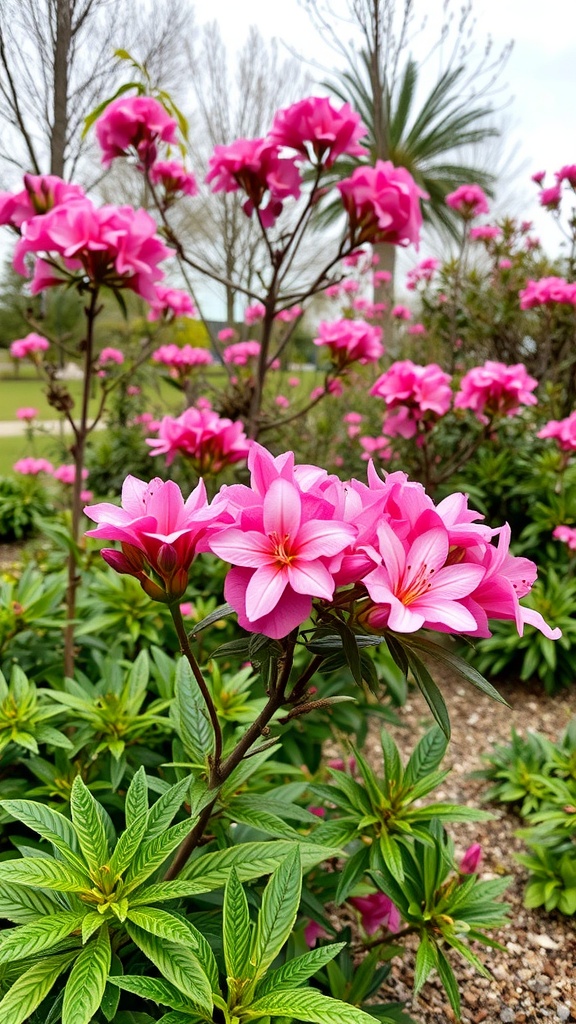
Azaleas are a stunning choice for landscape design. Their vibrant pink blooms create a lively atmosphere in any garden. These flowers are often used to add color and life to outdoor spaces.
In the image, you can see clusters of bright pink azaleas surrounded by lush green foliage. This combination not only enhances the visual appeal but also provides a lovely contrast. The arrangement of the flowers adds depth to the landscape, making it inviting and cheerful.
Azaleas thrive in various settings, from formal gardens to casual backyards. They can be planted in groups or as individual specimens, depending on the desired effect. Their versatility makes them a favorite among garden enthusiasts.
Incorporating azaleas into your garden can transform the space into a vibrant retreat. They bloom in spring, bringing joy and beauty just when you need it most. Whether you’re looking to create a serene spot or a lively gathering area, azaleas can help achieve that vision.
Companion Plants for Azaleas
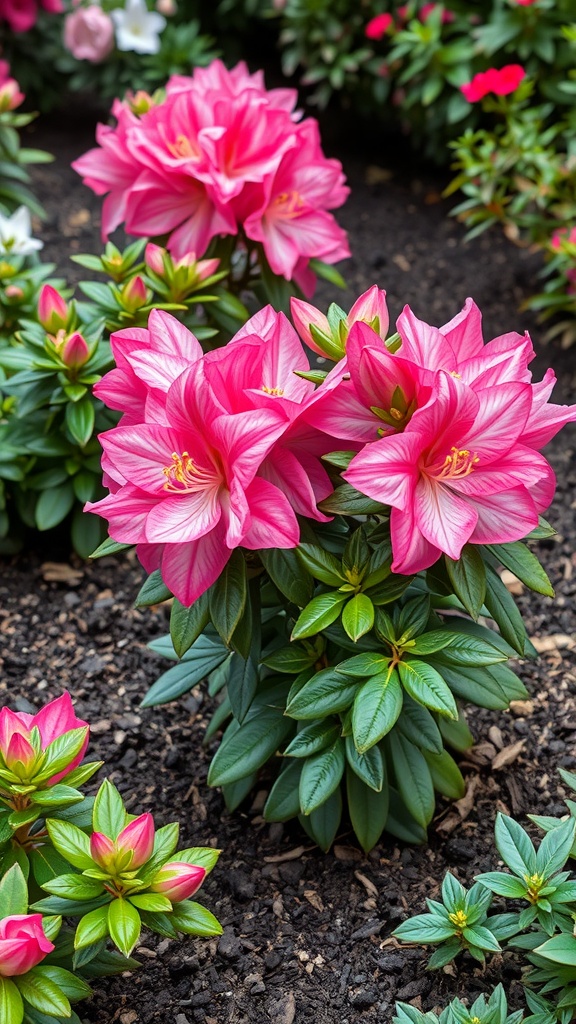
Azaleas are stunning plants that bring vibrant colors to any garden. Their bright pink flowers, as seen in the image, create a cheerful atmosphere. Pairing azaleas with the right companions can enhance their beauty and health.
Consider planting ferns alongside azaleas. Their lush green foliage contrasts nicely with the colorful blooms. Ferns thrive in similar conditions, making them a perfect match.
Another great companion is the hosta. These plants have broad leaves that can provide shade to the roots of azaleas, helping to retain moisture. Plus, their different leaf shapes add visual interest.
For a pop of color, try adding some spring bulbs like daffodils or tulips. They bloom early in the season, providing a lovely transition before the azaleas take center stage.
Finally, ground covers like creeping thyme or ajuga can fill in the spaces around azaleas. They help suppress weeds and keep the soil moist, benefiting the azaleas.
Vibrant Azalea Varieties for Your Garden

Azaleas bring a burst of color to any garden, and the image showcases some stunning varieties. The bright pink and white blooms stand out beautifully against the lush green leaves. These flowers are not just pretty; they also attract pollinators, making your garden lively.
When choosing azaleas, consider the different types available. Some varieties bloom in early spring, while others may bloom later. This allows you to enjoy their beauty for a longer period. The image highlights the classic pinks, but azaleas also come in shades of red, white, and even yellow.
Planting azaleas in groups can create a striking visual effect. Mix different colors for a vibrant display or stick to one color for a more uniform look. They thrive in partial shade, making them perfect for spots in your garden that don’t get full sun.
With proper care, azaleas can flourish for years. Regular watering and mulching will keep the soil moist and healthy. So, if you want to add some charm to your garden, consider these lovely azalea varieties!
Designing a Zen Garden with Azaleas
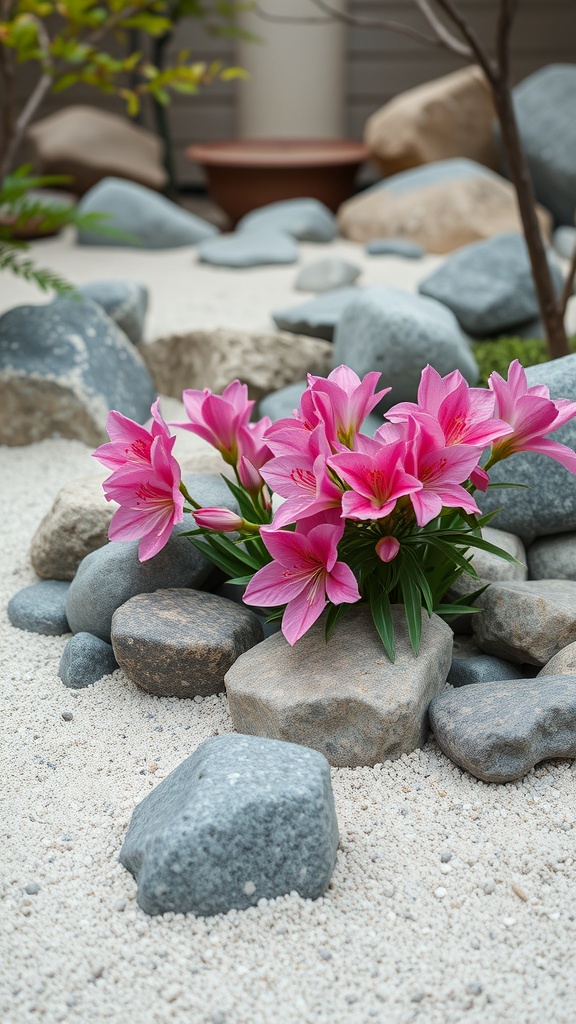
Creating a Zen garden with azaleas can be a delightful experience. These vibrant flowers add a pop of color to the serene environment. The soft pink hues of azaleas contrast beautifully with the natural stones and sand, creating a peaceful scene.
Incorporating azaleas into your garden design can enhance the overall aesthetic. Position them among smooth stones and gravel to mimic the natural beauty found in traditional Zen gardens. The flowers can serve as focal points, drawing the eye and inviting relaxation.
When designing your garden, think about balance. Use larger stones to anchor the space, while the azaleas can bring life and energy. This combination creates harmony, making your garden a perfect spot for meditation or quiet reflection.
Don’t forget to consider the layout. A winding path of stones leading to the azaleas can guide visitors through the garden. This gentle flow encourages exploration and appreciation of the natural beauty around.
Creating a Layered Garden with Azaleas
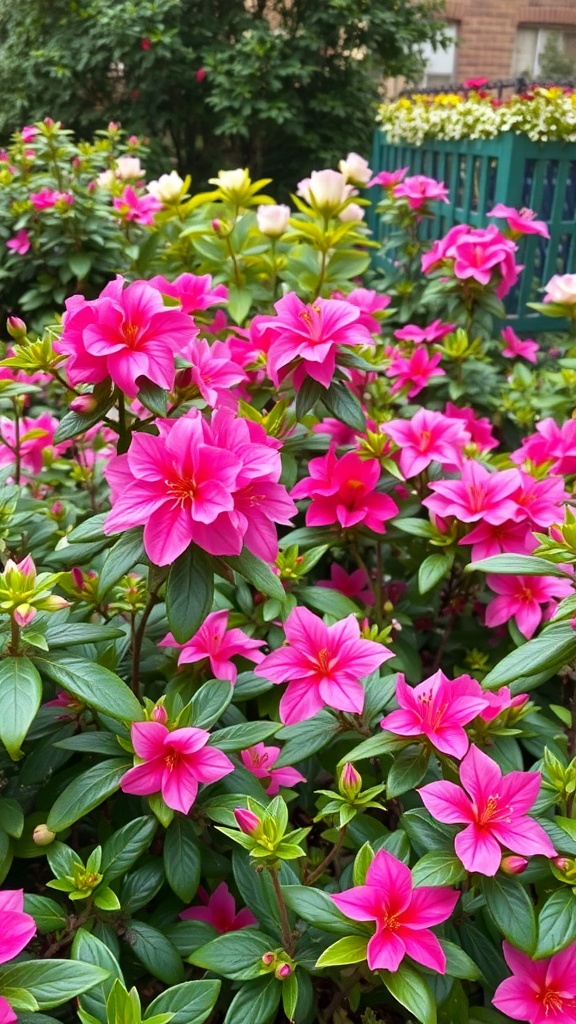
Azaleas are a fantastic choice for creating a layered garden. Their vibrant colors can brighten up any space. In the image, you can see a stunning display of pink azaleas, surrounded by lush green foliage. This combination adds depth and texture to the garden.
When planning your layered garden, think about the height of your plants. Place taller plants at the back and shorter ones in front. Azaleas can be used in the middle layer, providing a beautiful pop of color. Mixing different varieties can also create an interesting visual effect.
Don’t forget about the seasons! Azaleas bloom in spring, so consider adding other plants that flower at different times. This way, your garden will have color throughout the year. Incorporating evergreen plants can also help maintain structure during the winter months.
Lastly, ensure your azaleas have the right conditions. They thrive in well-drained, acidic soil and prefer partial shade. With the right care, your layered garden will be a stunning sight to behold!
Year-Round Care Tips for Azaleas
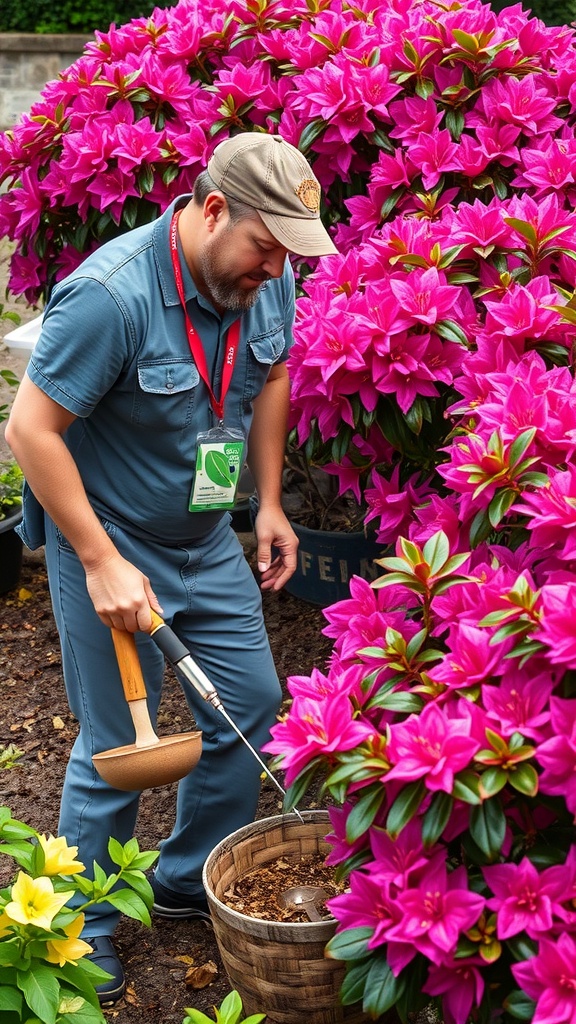
Azaleas are stunning plants that can brighten up any garden. The vibrant pink blooms in the image show just how beautiful these flowers can be. Caring for them throughout the year is key to keeping them healthy and thriving.
In spring, focus on pruning. This helps shape the plant and encourages new growth. Make sure to remove any dead or weak branches. After blooming, a light trim can keep them looking their best.
During the summer, azaleas need regular watering. They prefer moist soil, but be careful not to overwater. Mulching around the base can help retain moisture and keep the roots cool.
As fall approaches, it’s time to prepare for winter. Fertilizing in late summer can give them the nutrients they need to survive the colder months. Protecting the roots with mulch can also help them endure frost.
In winter, check for any signs of damage or pests. Keeping an eye on your azaleas ensures they stay healthy and ready to bloom again in spring.
Azaleas and Their Ideal Growing Conditions

Azaleas are stunning flowers that can brighten up any garden. The image shows vibrant pink azaleas blooming, showcasing their beauty and charm. These flowers thrive in the right conditions, making them a favorite among gardeners.
To grow azaleas successfully, they need well-drained, acidic soil. A pH level between 5.5 and 6.0 is ideal. Adding organic matter can help improve soil quality. Azaleas also love moisture, so regular watering is important, especially during dry spells.
Sunlight plays a key role in their growth. Azaleas prefer partial shade, especially in hotter climates. Too much direct sunlight can scorch their leaves. Finding the right balance of light will help them flourish.
Fertilizing azaleas can boost their growth. A slow-release fertilizer designed for acid-loving plants is a good choice. Applying it in spring can give them the nutrients they need for a vibrant bloom.
With the right care, azaleas can create a stunning display in any garden. Their colorful flowers and lush foliage make them a delightful addition to outdoor spaces.
Azaleas in Container Gardening
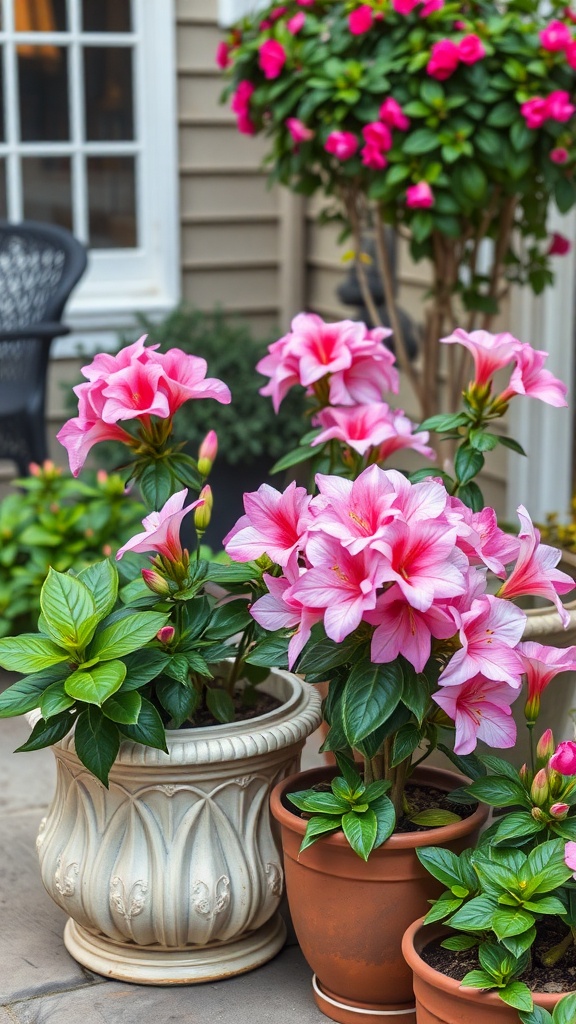
Container gardening with azaleas is a delightful way to bring color and life to your outdoor space. The image shows beautiful pink azaleas in various pots, showcasing their vibrant blooms. These flowers can brighten up any patio or garden.
Using containers allows you to control the soil and drainage, which is essential for azaleas. They thrive in well-drained, acidic soil. Make sure to choose pots with drainage holes to prevent water from sitting at the bottom.
Azaleas also love sunlight, but they prefer partial shade. Placing them in a spot where they can get morning sun and afternoon shade works well. This way, you can enjoy their beauty without worrying about them wilting in the heat.
Another benefit of container gardening is the flexibility it offers. You can easily move your azaleas around to find the perfect spot. This is especially handy if you want to change your garden’s look or protect the plants from harsh weather.
Lastly, don’t forget to water your azaleas regularly. They like consistent moisture, but be careful not to overwater. With the right care, your azaleas will flourish and provide a stunning display throughout the blooming season.
Incorporating Azaleas into a Woodland Garden
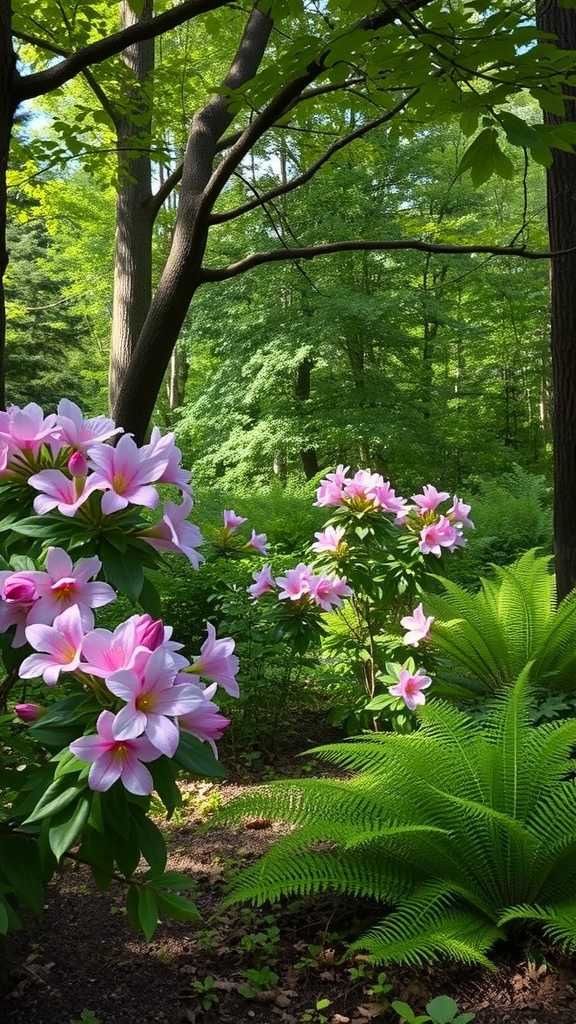
Azaleas bring a splash of color to woodland gardens. Their vibrant blooms stand out against the lush greenery of trees and ferns. In the image, you can see beautiful pink azaleas thriving in a natural setting. They create a lovely contrast with the surrounding foliage.
When planning your woodland garden, think about where to place these flowers. They prefer partial shade, making them perfect for areas under taller trees. Grouping them in clusters can enhance their visual impact. This creates a stunning focal point that draws the eye.
Pairing azaleas with ferns, as shown in the image, works wonderfully. The delicate fronds of ferns complement the bold blooms. This combination adds texture and depth to your garden. Don’t forget to consider the soil; azaleas thrive in well-drained, acidic soil.
Watering is essential, especially in the first year after planting. Keeping the soil moist helps them establish strong roots. With the right care, your azaleas will flourish and provide beauty for years to come.
Azaleas for Small Urban Gardens
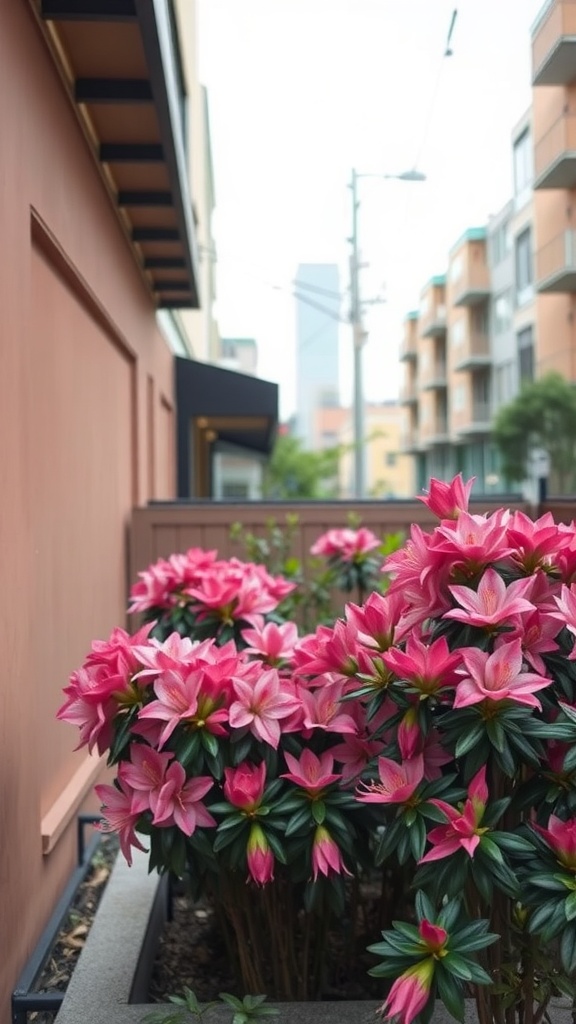
Azaleas are perfect for small urban gardens. Their vibrant pink flowers bring life to any space. In the image, you can see a lovely display of azaleas blooming beautifully against a modern backdrop. This combination creates a striking visual appeal.
These plants thrive in containers, making them ideal for patios or balconies. They don’t need a lot of space, yet they offer a burst of color that can brighten up any area. The rich green leaves contrast nicely with the bright blooms, adding depth to the garden.
When choosing azaleas, consider the variety that suits your garden’s sunlight and soil conditions. They can be low-maintenance, requiring just a bit of care to flourish. With the right conditions, these flowers can create a stunning focal point, making your urban garden feel more inviting.
Wildlife-Friendly Azalea Gardens
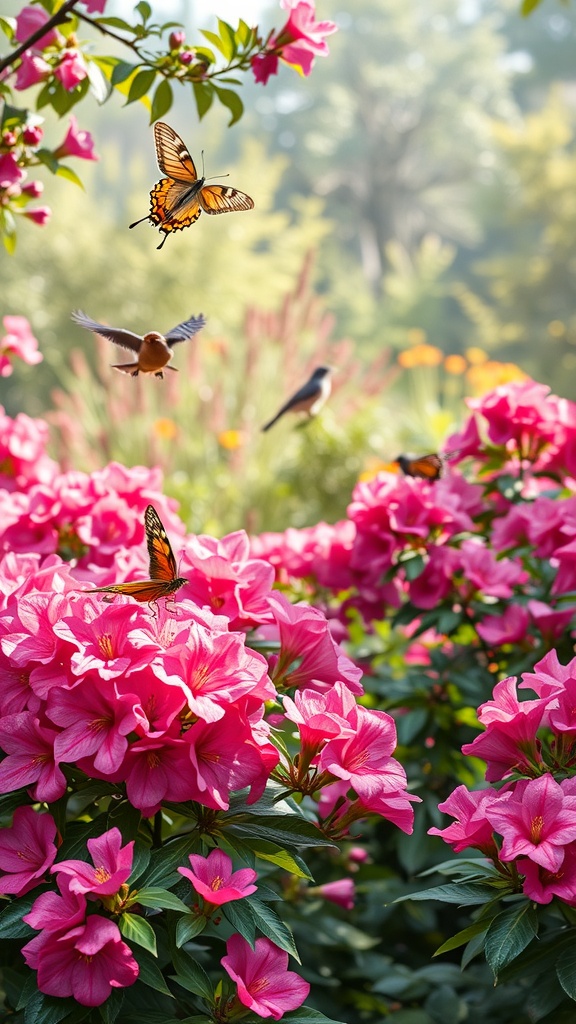
Azalea gardens can be a lively spot for both plants and animals. The vibrant pink blooms attract butterflies and birds, creating a colorful scene. In this image, you can see butterflies fluttering above the azaleas, while small birds dart around, enjoying the nectar and the shelter these flowers provide.
Creating a wildlife-friendly azalea garden is simple. Start by planting a variety of azaleas to attract different species. The bright colors and sweet scents are irresistible to pollinators. Adding native plants nearby can further enhance the habitat, offering food and shelter for local wildlife.
Water features, like small ponds or birdbaths, can also draw in more visitors. Birds love to bathe and drink, while butterflies need water to thrive. By incorporating these elements, your garden can become a bustling hub of activity.
Seasonal Changes in Azalea Gardens
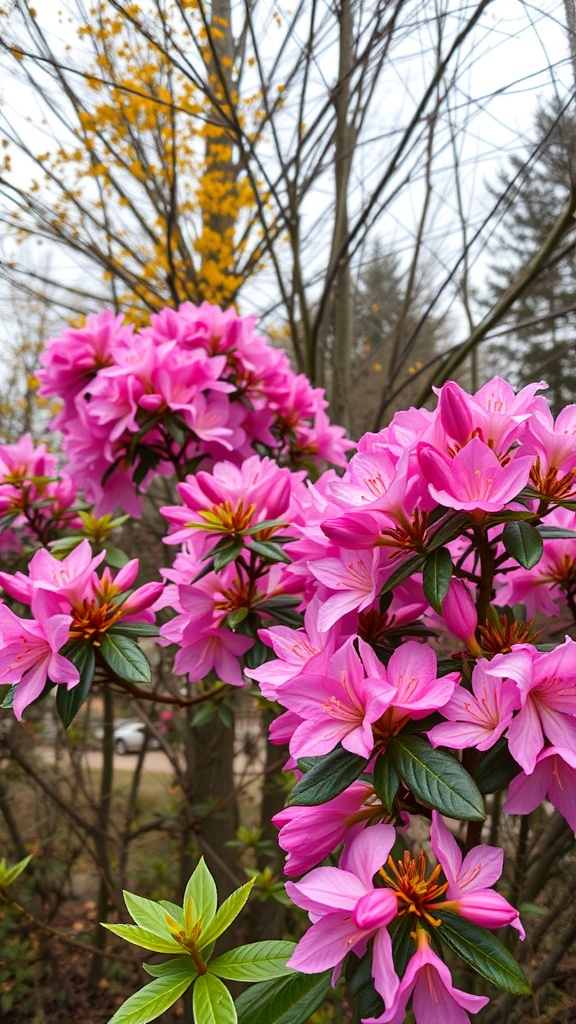
Azalea gardens bring a burst of color, especially in spring. The vibrant pink blooms in the image showcase the beauty these flowers offer. As the seasons shift, the garden transforms, revealing different aspects of nature’s charm.
In spring, azaleas are in full bloom, creating a stunning display. Their bright colors stand out against the backdrop of budding leaves and trees. As summer approaches, the blooms may fade, but the lush green foliage remains, providing a rich setting for other plants.
Come autumn, the scene changes again. Leaves turn shades of yellow and orange, adding warmth to the garden. The azaleas may still hold onto some blooms, creating a lovely contrast with the fall colors. Winter brings a quieter time for the garden, as the azaleas rest, waiting for the warmth of spring to return.
The Role of Azaleas in Garden Color Schemes
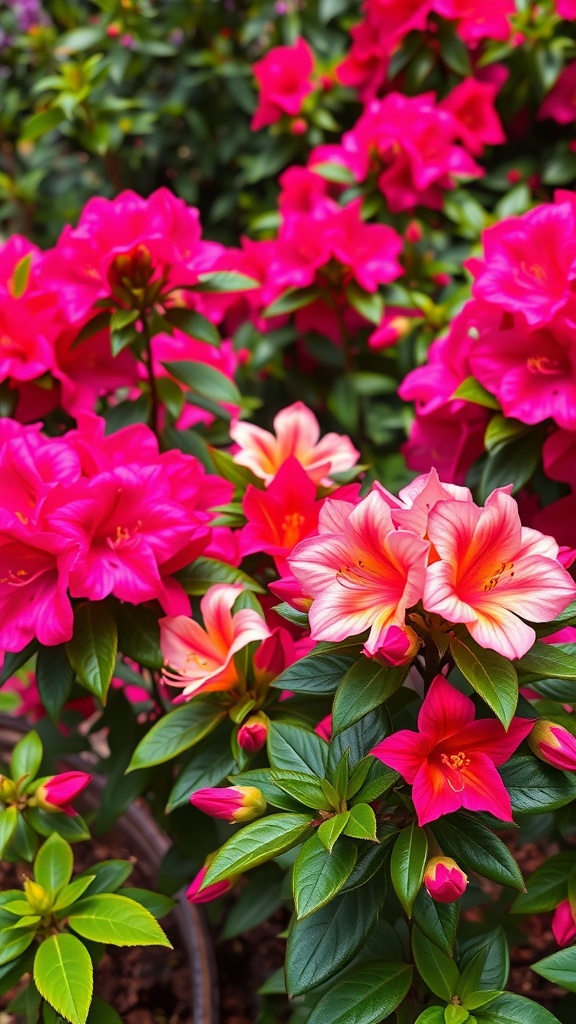
Azaleas are a fantastic choice for adding color to any garden. Their bright blooms can transform a dull space into a vibrant oasis. The image shows a stunning array of azaleas in shades of pink, showcasing their ability to create a lively atmosphere.
These flowers come in various colors, making them versatile for different garden themes. Pairing azaleas with other plants can enhance the overall look. For instance, combining them with white or yellow flowers can create a beautiful contrast.
Azaleas bloom in spring, bringing life to gardens just when everything starts to wake up. Their lush foliage and striking flowers can be the focal point of your garden. Whether planted in clusters or as standalone specimens, they always catch the eye.
Incorporating azaleas into your garden design can also help establish a seasonal color palette. As they bloom, they can set the tone for the rest of the garden, influencing the choice of companion plants. This makes them not just a pretty flower, but a key player in garden aesthetics.
Azaleas and Garden Pathways
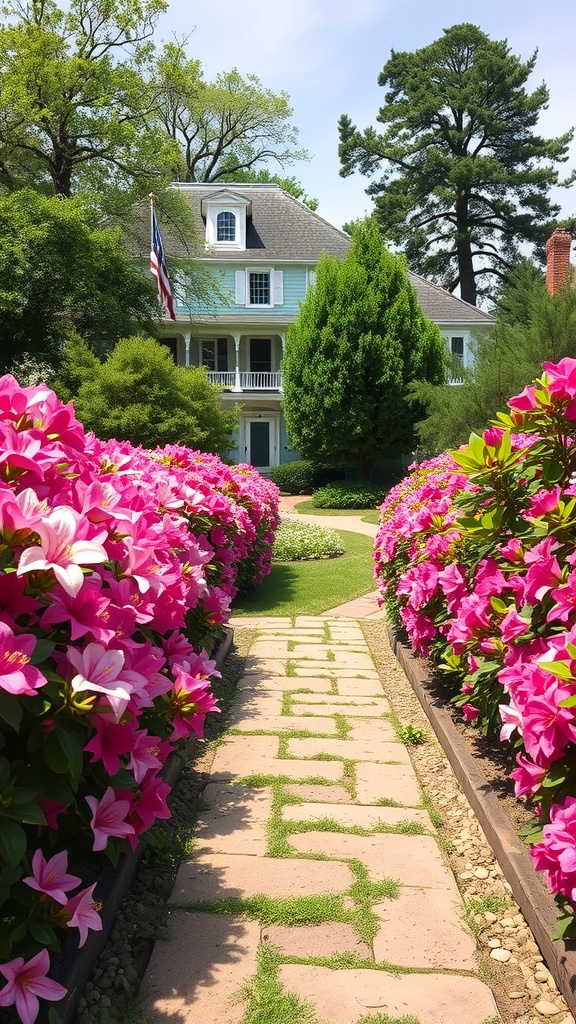
Azaleas are a stunning addition to any garden, and they shine even brighter when paired with charming pathways. The vibrant pink blooms create a lively atmosphere, inviting visitors to stroll through the garden. Picture a pathway lined with these beautiful flowers, leading to a lovely home in the background.
The pathway itself is made of stone, adding a rustic touch to the scene. It guides you through the lush greenery and colorful azaleas, making each step feel special. The combination of the flowers and the pathway creates a warm and welcoming vibe, perfect for enjoying a sunny day.
As you walk along, the sweet scent of the azaleas fills the air, enhancing the experience. This setting is not just about beauty; it’s about creating a peaceful retreat. Whether you’re looking to relax or entertain, a garden with azaleas and a well-defined pathway can be the perfect spot.
Pruning Azaleas for Optimal Growth
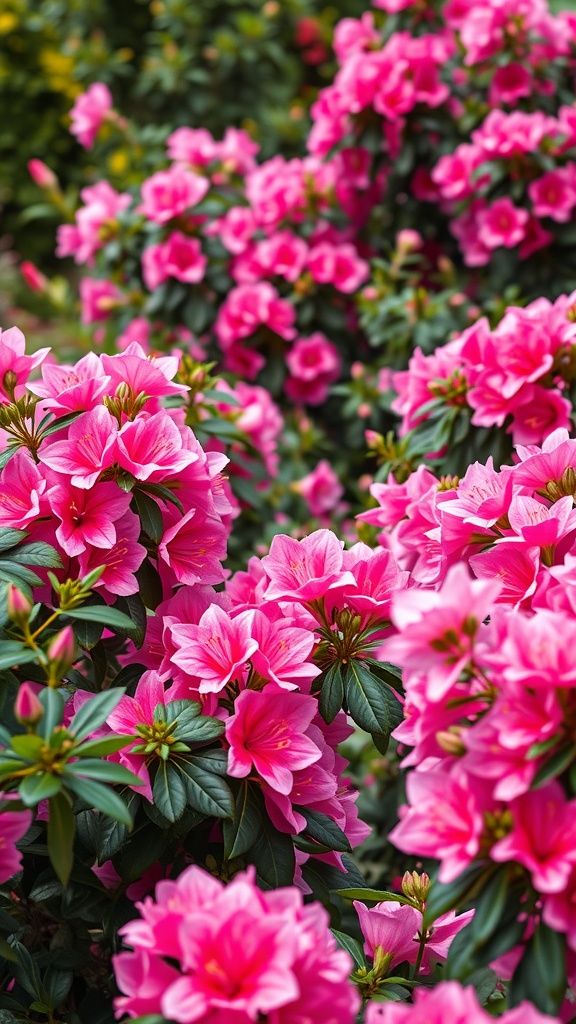
Azaleas are stunning plants that can brighten up any garden with their vibrant blooms. In the image, you can see clusters of pink azaleas, showcasing their lush petals and rich green leaves. These flowers are not just beautiful; they also require some care to thrive.
Pruning azaleas is key to keeping them healthy and promoting growth. The best time to prune is right after they finish blooming. This timing helps avoid cutting off next year’s flower buds. Use sharp, clean shears to make precise cuts. Focus on removing any dead or weak branches to encourage new growth.
When pruning, aim to shape the plant gently. You want to maintain a natural look while ensuring good air circulation. This helps prevent diseases and allows sunlight to reach all parts of the plant. Regular pruning can lead to more blooms and a fuller appearance.
After pruning, consider adding mulch around the base of the azaleas. This helps retain moisture and keeps the roots cool. With proper care, your azaleas will continue to flourish, adding beauty to your garden for years to come.
Maintaining Soil Health for Azaleas
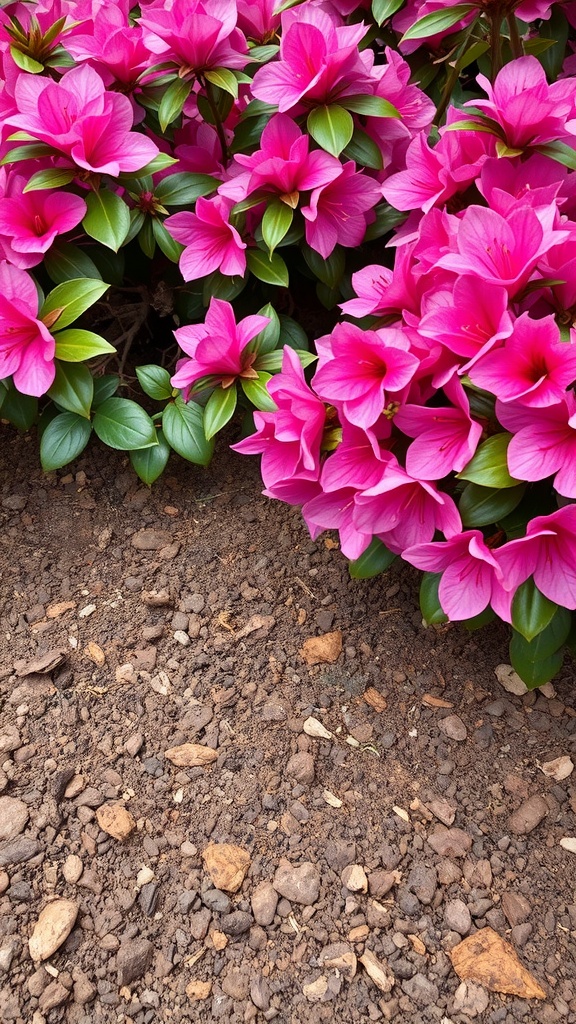
Azaleas are stunning flowers that bring vibrant colors to any garden. To keep them thriving, healthy soil is key. The image shows beautiful pink azaleas blooming, surrounded by rich, earthy soil. This soil is the foundation for their growth.
First, it’s important to test the soil pH. Azaleas prefer slightly acidic soil, ideally between 5.5 and 6.0. You can easily find soil testing kits at garden centers. Adjusting the pH can help your azaleas flourish.
Next, organic matter is your friend. Adding compost or well-rotted manure can improve soil structure and provide essential nutrients. This not only benefits the azaleas but also encourages beneficial microbes in the soil.
Don’t forget about drainage! Azaleas dislike sitting in water. Ensure the soil drains well to prevent root rot. If your garden has heavy clay soil, consider amending it with sand or peat moss.
Regular mulching is another great way to maintain soil health. A layer of mulch helps retain moisture and suppress weeds. Plus, it adds organic matter as it breaks down over time.
Azalea Festivals and Garden Tours
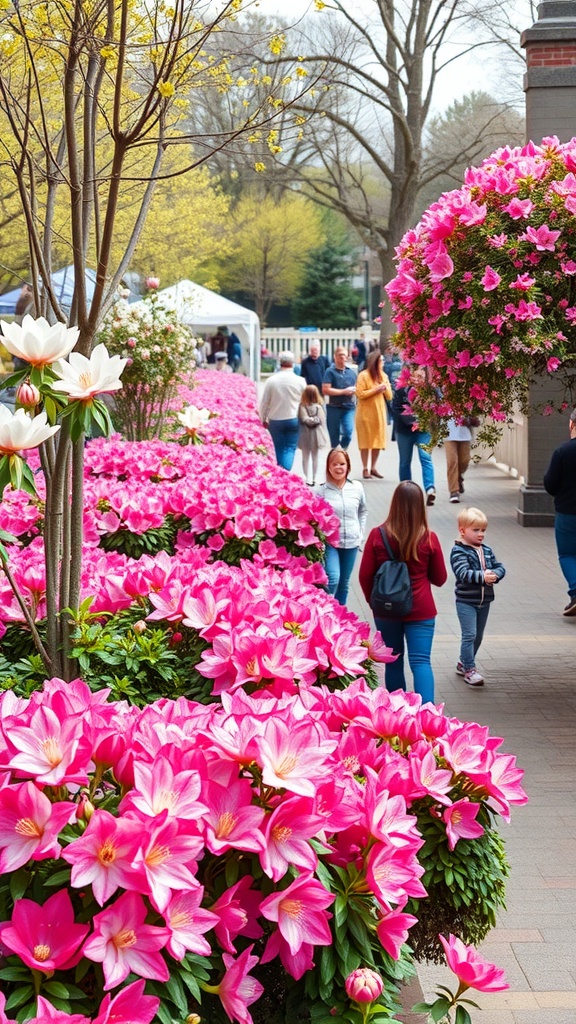
Azalea festivals are a delightful way to celebrate spring. The vibrant pink blooms create a stunning backdrop for gatherings. People stroll through gardens filled with these beautiful flowers, enjoying the sights and sounds of nature.
In the image, you can see a lively scene where families and friends are enjoying a day out among the azaleas. The flowers are in full bloom, showcasing their bright colors. Hanging baskets add extra charm to the setting, making it a perfect spot for photos.
Many festivals offer guided tours, allowing visitors to learn about different azalea varieties. You might also find local vendors selling crafts and food, adding to the festive atmosphere. These events are not just about the flowers; they bring communities together.
Whether you’re an avid gardener or just love a beautiful day outdoors, azalea festivals are a must-visit. They provide a chance to appreciate nature and enjoy time with loved ones.
Azaleas in Historic Gardens

Azaleas bring a splash of color to historic gardens, creating a stunning visual experience. Their vibrant pink blooms stand out beautifully against the backdrop of classic architecture.
In this image, you can see a lovely arrangement of azaleas in full bloom, framing a grand building. The flowers are lush and inviting, drawing the eye toward the elegant structure behind them.
Historic gardens often feature azaleas for their beauty and ability to thrive in various conditions. They add charm and character, making these spaces feel alive and welcoming.
Walking through a garden filled with azaleas is a treat for the senses. The colors, scents, and textures create a peaceful atmosphere, perfect for relaxation or a leisurely stroll.
